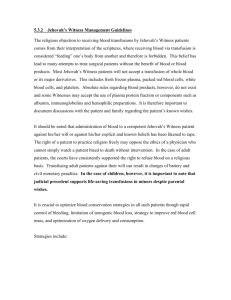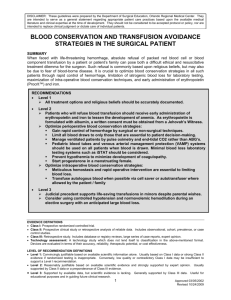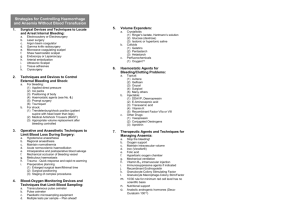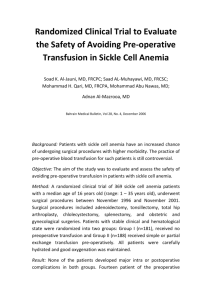ICU SEDATION GUIDELINES - SurgicalCriticalCare.net
advertisement
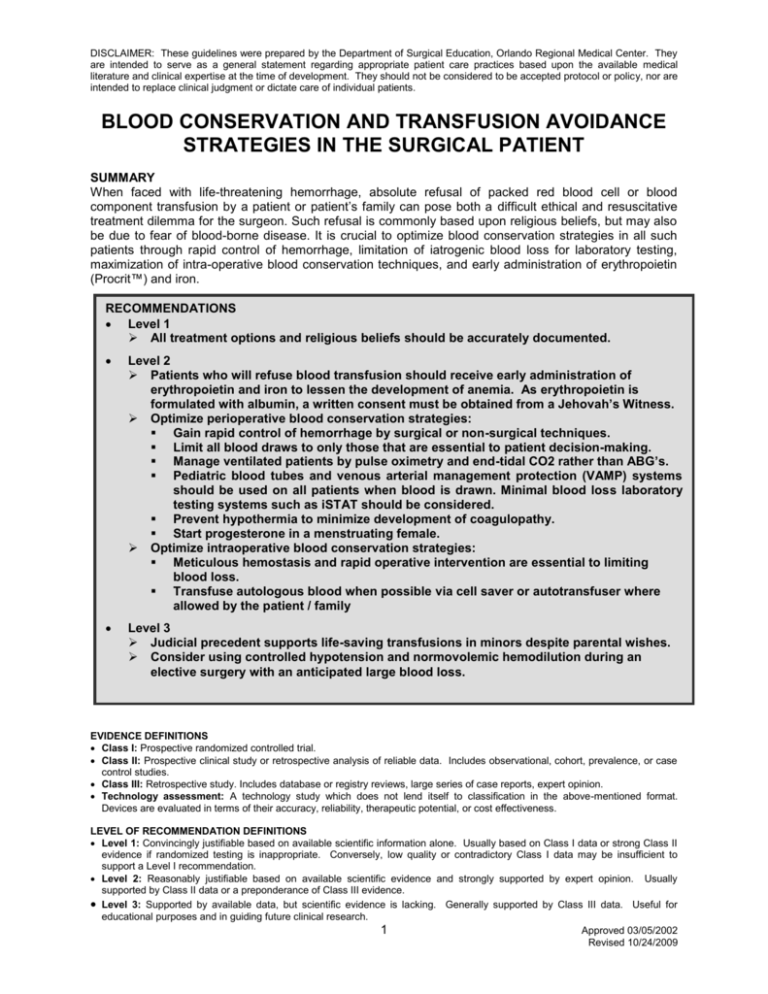
DISCLAIMER: These guidelines were prepared by the Department of Surgical Education, Orlando Regional Medical Center. They are intended to serve as a general statement regarding appropriate patient care practices based upon the available medical literature and clinical expertise at the time of development. They should not be considered to be accepted protocol or policy, nor are intended to replace clinical judgment or dictate care of individual patients. BLOOD CONSERVATION AND TRANSFUSION AVOIDANCE STRATEGIES IN THE SURGICAL PATIENT SUMMARY When faced with life-threatening hemorrhage, absolute refusal of packed red blood cell or blood component transfusion by a patient or patient’s family can pose both a difficult ethical and resuscitative treatment dilemma for the surgeon. Such refusal is commonly based upon religious beliefs, but may also be due to fear of blood-borne disease. It is crucial to optimize blood conservation strategies in all such patients through rapid control of hemorrhage, limitation of iatrogenic blood loss for laboratory testing, maximization of intra-operative blood conservation techniques, and early administration of erythropoietin (Procrit™) and iron. RECOMMENDATIONS Level 1 All treatment options and religious beliefs should be accurately documented. Level 2 Patients who will refuse blood transfusion should receive early administration of erythropoietin and iron to lessen the development of anemia. As erythropoietin is formulated with albumin, a written consent must be obtained from a Jehovah’s Witness. Optimize perioperative blood conservation strategies: Gain rapid control of hemorrhage by surgical or non-surgical techniques. Limit all blood draws to only those that are essential to patient decision-making. Manage ventilated patients by pulse oximetry and end-tidal CO2 rather than ABG’s. Pediatric blood tubes and venous arterial management protection (VAMP) systems should be used on all patients when blood is drawn. Minimal blood loss laboratory testing systems such as iSTAT should be considered. Prevent hypothermia to minimize development of coagulopathy. Start progesterone in a menstruating female. Optimize intraoperative blood conservation strategies: Meticulous hemostasis and rapid operative intervention are essential to limiting blood loss. Transfuse autologous blood when possible via cell saver or autotransfuser where allowed by the patient / family Level 3 Judicial precedent supports life-saving transfusions in minors despite parental wishes. Consider using controlled hypotension and normovolemic hemodilution during an elective surgery with an anticipated large blood loss. EVIDENCE DEFINITIONS Class I: Prospective randomized controlled trial. Class II: Prospective clinical study or retrospective analysis of reliable data. Includes observational, cohort, prevalence, or case control studies. Class III: Retrospective study. Includes database or registry reviews, large series of case reports, expert opinion. Technology assessment: A technology study which does not lend itself to classification in the above-mentioned format. Devices are evaluated in terms of their accuracy, reliability, therapeutic potential, or cost effectiveness. LEVEL OF RECOMMENDATION DEFINITIONS Level 1: Convincingly justifiable based on available scientific information alone. Usually based on Class I data or strong Class II evidence if randomized testing is inappropriate. Conversely, low quality or contradictory Class I data may be insufficient to support a Level I recommendation. Level 2: Reasonably justifiable based on available scientific evidence and strongly supported by expert opinion. Usually supported by Class II data or a preponderance of Class III evidence. Level 3: Supported by available data, but scientific evidence is lacking. Generally supported by Class III data. Useful for educational purposes and in guiding future clinical research. 1 Approved 03/05/2002 Revised 10/24/2009 INTRODUCTION Anemia is a recognized complication of major trauma, surgery, and critical illness. In most patients, lifethreatening anemia from hemorrhage is readily corrected with packed red blood cell transfusions. Jehovah’s Witnesses represent the majority of patients who refuse to accept the administration of blood transfusions. A smaller percentage of patients may refuse blood transfusion based upon fear of bloodborne disease such as HIV / AIDS or hepatitis. As a consequence, management of the anemic patient who refuses transfusion requires an alternative aggressive approach. In 1869, Charles Russell founded the religious group called the Jehovah’s Witnesses. There are over one million members in the USA and 6.7 million worldwide. The refusal of blood transfusion, which began in 1945, is based on a strict interpretation of the biblical passages: “the life of all flesh is the blood thereof: whoever eat it shall be cut off” (Lev. 17:10-16) and “abstain from the meats offered to idols and from blood” (Acts 15:28-29) (1-3). Transfusion of blood components (white blood cells, platelets, plasma, and autologous stored blood) is unacceptable to the Jehovah’s Witness. They believe that “the time on Earth gained from a blood transfusion is inconsequential to the eternal spiritual damnation that results from it.” (3). If a Jehovah’s Witness consents to a blood transfusion, “…he indicates by his own actions that he no longer wishes to be one of Jehovah’s Witnesses” (3). If they receive a blood transfusion against their will, they feel as if they have been personally assaulted because of their strong belief that God forbids the receipt of blood (2). There is variability within the religion and not all members approach the blood ban equally. Most Jehovah’s Witnesses will accept autologous blood transfusion if it is kept in a continuous circuit such as a cell saver or during hemodialysis. The vast majority of the Jehovah’s Witness population will accept albumin, recombinant human erythropoietin, and other factor concentrates. Since albumin is used in the formulation of erythropoietin (Procrit™), a written consent should be obtained prior to using this medication (1,4). The right of a patient to practice religion freely may oppose the ethics of a physician who cannot watch a patient bleed to death without intervention. In the case of adult patients, the courts have consistently supported the right to refuse blood on a religious basis. Transfusing patients against their will can result in charges of battery and civil monetary penalties (5). In the case of minor children, however, the U.S. Supreme Court in Prince vs. Commonwealth of Massachusetts has ruled that, “Parents may be free to become martyrs themselves, but it does not follow that they are free, in identical circumstances, to make martyrs of their children.” (6). The court determined that the right to practice religion freely does not include liberty to expose children to ill health or death (7). Court-directed blood transfusion in minor children may be considered as a potentially lifesaving intervention. Practicing blood conservation techniques is essential to decreasing the development of anemia and need for blood transfusion. Simple blood conservation techniques include rapid control of hemorrhage and limiting blood draws. Phlebotomy for routine laboratory analyses is commonly associated with a blood loss of up to 70 mL of blood per day. Critically ill patients with extended ICU stays historically demonstrated an average blood transfusion rate of two units of packed red blood cells per week. With greater attention to blood conservation and avoidance of unnecessary blood tests, this blood loss has decreased in recent years. Reduced erythropoiesis and bioavailability of iron appear to contribute to ongoing anemia without acute blood loss in the critically ill. Recent studies indicate a blunted erythropoietin response to acute anemia and low serum iron (despite adequate iron stores) secondary to increased proinflammatory cytokines (8). The early administration of erythropoietin and iron may circumvent this reduction (8). Controlled hypotension (mean arterial blood pressure 50-55 mmHg) and normovolemic hemodilution have been used to manage Jehovah’s Witnesses undergoing elective surgery with expected largevolume blood loss such as orthopedic and cardiac surgery, or liver resections. Normovolemic 2 Approved 03/05/2002 Revised 10/24/2009 hemodilution is most efficacious if at least a thousand milliliters of autologous blood is withdrawn from the patient prior to the commencement of surgery. This technique decreases the blood’s viscosity, increases cardiac output, and decreases intraoperative blood loss. These techniques must be used with caution in patients with renal, hepatic, cerebral or cardiac compromise (1). LITERATURE REVIEW Atabek et al enrolled 40 surgical Jehovah’s Witness patients in an investigational trial (9). Twenty patients received erythropoietin (300 IU/kg IV three times per week for one week then 150 IU/kg IV three times per week for two weeks and iron [dose not specified]) postoperatively. The other 20 patients received no erythropoietin. The starting hematocrit was similar (15.8% in the erythropoietin group versus 12.8% in the control group). Administration of erythropoietin accelerated the hematocrit recovery in the first week with hematocrit levels of 19.3% vs. 12.5% in the control group. Atabek concluded that immediate postoperative use of erythropoietin may avoid or reduce blood transfusion. Koestner et al published a case report involving a 36-year-old Jehovah’s Witness female with multiple trauma (10). Compassionate use erythropoietin was started on post trauma day six, 300 IU/kg IV QD for three days then 150 IU/kg SQ three times a week. Her hematocrit increased from 13% to 37%. The patient was also given intramuscular injection of iron and progesterone, (dose not specified). The patient was discharged on post trauma day forty-two without a single blood transfusion. DeMeester et al published a case report involving a 38-year-old Jehovah’s Witness male with multiple trauma (11). On hospital day one, the patient received erythropoietin 300 IU/kg IV QD for three days then 150 IU/kg SC three times per week for total of 13 doses. Iron and MVI supplements were given (dose not specified). The patient’s hematocrit increased from 8.8% to 20.3% with no blood transfusion upon discharge on post trauma day 32. DeMeester demonstrated an acceleration of the hematocrit level with early administration of erythropoietin versus waiting until post trauma day six as in the Koestner study. Victorino et al published a retrospective review of 58 traumatized Jehovah’s Witnesses and used both normovolemic hemodilution and controlled hypotensive anesthesia for an elective open reduction and internal fixation of an acetabulum (1). The patient was a 43-year-old male with multiple fractures status post fall. Post trauma day seven, the patient went to the OR with estimated blood loss of 2200 mL and was given three units of cell saver blood. Post trauma day nine, the patient’s hemoglobin level dropped from 9 g/dL to 5.7 g/dL. The patient was discharged on post trauma day sixteen with a hemoglobin of 7.0 g/dL without having received a blood transfusion. Vaziri et al describe a young trauma patient who received blood transfusions until his family arrived and informed the physicians about the patient’s Jehovah’s Witness beliefs (12). He family refused further blood products, but did give consent for erythropoietin and iron. Blood conservation strategies were initated. The patient’s hemoglobin dropped to a nadir of 2.7 gm/dL, but rose to 8.4 gm/dL at discharge. The authors describe their decision, approved by the family, to pursue early lower extremity amputation rather than attempting the multiple operative procedures and blood loss that would have been required to pursue limb salvage. Nelson et al. reported a 16-year experience with 77 traumatically injured Jehovah’s Witnesses at a Level I trauma center (13). The religious preference of 68% of these patients was not known to the attending physician and over 50% had no documentation of their beliefs in the medical record. Despite this, only 4 patients (5%) received a blood transfusion, two patients before their religious beliefs were made known. The authors emphasized the importance of asking about religious preferences as part of the initial patient history. 3 Approved 03/05/2002 Revised 10/24/2009 Clinical Management Strategies for Jehovah’s Witnesses Strategy Minimize iatrogenic blood loss Minimize intraoperative blood loss Enhance red blood cell production Ensure hemostasis, prophylactic or therapeutic Maintain blood volume Enhance oxygen carrying capacity Method of Achievement Consequential blood tests only Elimination of unnecessary phlebotomy / routine blood draws Capillary blood tubes for arterial blood gases Pediatric blood tubes for other laboratory tests Meticulous surgical technique / hemostasis Isovolemic hemodilution Hypervolemic hemodilution Intraoperative blood salvage Recombinant human erythropoietin Supplemental iron, vitamin B12, and folate Early operative intervention Necessary dressing changes only Correction of coagulopathies Desmopressin Antifibrinolytic agents Aprotinin Recombinant human factor VIIa Crystalloid solutions Synthetic colloid solutions Maintain oxygen saturation 98% Minimize oxygen demand through sedation, mechanical ventilation, and neuromuscular blockade Mild permissive hypercapnea / metabolic acidosis Adapted from references 3,12. REFERENCES 1. Victorino G, Wisner DH, Jehovah’s Witnesses: unique problems in a unique trauma population. J Am Coll Surg 1997; 184:458-467. 2. Migden DR, Braen GR, The Jehovah’s Witness blood refusal card: ethical and medicolegal considerations for emergency physicians. Academic Emergency Medicine 1998; 5:815-835. 3. Hughes DB, Ullery BW, Barie PS. The contemporary approach to the care of Jehovah’s Witnesses. J Trauma 2008; 65:237-247. 4. Bennett DR, Shulman IA, Practical issues when confronting the patient who refuses blood transfusion therapy. Am J Clin Pathol 1997; 107:S23-S27. 5. Malette v Shulman. Dominion Law Reports (Canada) 1990; 67:3221-39. 6. Prince v Commonwealth of Massachusetts, 321 US 158 (1944). 7. Groudine SB, The child Jehovah’s Witness patient: A legal and ethical dilemma. Surgery 1997; 121:357-358. 8. Hobisch-Hagen P, et al. Blunted erythropoietic response to anemia in multiple traumatized patients. Crit Care Med 2001; 29:743-747. 9. Atabek U et al. Erythropoietin accelerates hematocrit recovery in post-surgical anemia. Am Surg 1995; 61:74-77. 10. Koestner JA et al. Use of recombinant human erythropoietin (r-HuEPO) in a Jehovah’s Witness refusing transfusion of blood products: case report. J Trauma 1990; 30:1406-1408. 11. DeMeester SR et al. Immediate use of recombinant erythropoietin in a Jehovah’s Witness following major blunt trauma. Contemporary Surgery 1994; 45:228-232. 12. Vaziri K, Roaldn JC, Robinson LL, Reines HD, Fakhry SM. Extreme anemia in an injured Jehovah’s Witness: A test of our understanding of the physiology of severe anemia and the threshold for blood transfusion. J Trauma 2009; 67:E11- E13. 13. Nelson BS. Heiskell LE, Cemaj S, O’Callaghan TA, Koller CE. Traumatically injured Jehoavah’s Witnesses: a sixteen-year experience of treatment and transfusion dilemmas at a level I trauma center. J Trauma 1995; 39:681-685. 4 Approved 03/05/2002 Revised 10/24/2009
